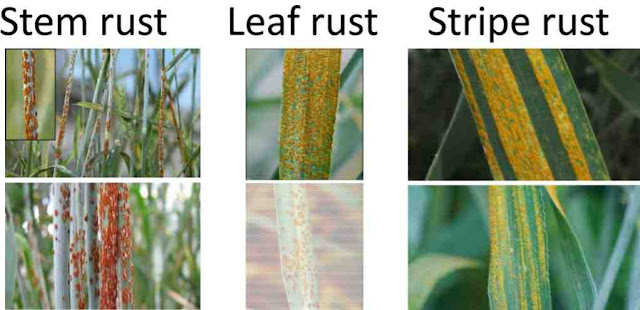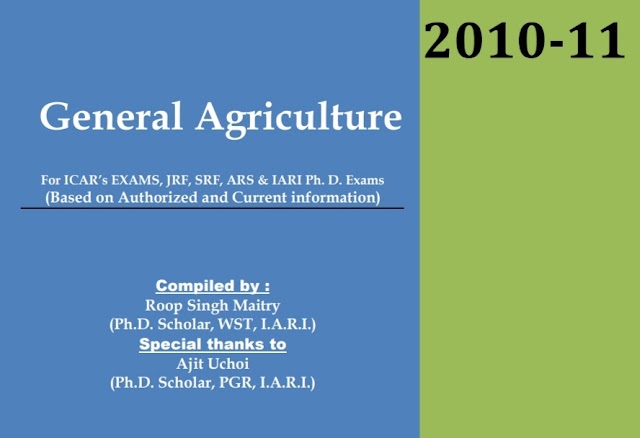Wheat diseases and their management
Hello!! Welcome to the agrifunda. Today, we are going to talk about important diseases of Wheat and their management. Again wheat is a global crop and it is affected by many diseases but some of them are most important and we were going to talk about those important diseases today. Among the most important diseases of wheat are Rust, Loose smut, Karnal bunt and spot blotch.
Wheat diseases
So these are the four major diseases that occur in India and around the world and let us take the example of Rust at the beginning. Rust of wheat are basically three types - one is known as Stem rust or Black rust and other one is Leaf rust or Brown rust and the third one is Yellow rust or stripe rust. All these three rust are caused by different organisms.
black rust
it is caused by Puccinia graminis f. sp. tritici Leaf rust is caused by Puccinia triticina and the Stripe rust is caused by Puccinia striiformis. The symptoms they produce on wheat are also different. The Stem rust initially they appear reddish brown in color but later this reddish brown Teliospores they become black in color so they appear as black. Leaf rust is also known as brown rust as the rust pustules are brown in color normally and Stripe rust it is easy to distinguish from the other two because here the leaf are caused you can see the stripes on the leaves that are caused by rust pustules. So this remains yellow and that is why these it is known as Yellow rust.
The pathogen rust survive as in the Volunteer wheat crops then lateral grasses and in cooler hilly areas of Himalayan range in North India and Nilgiri and Pulney Hills in the South India. These are the major areas and major mode of survival of the rust pathogens. IPM practices for management of Wheat rust includes Cultural, Chemical, Resistant cultivars source and Biological. Cultural practices include volunteer wheat plants which needs to be destructed and community effort is required for management of this particular pathogen. Application of fungicides include Propiconazole, Tebuconazole and we can also combine propiconazole along with Cyproconazole.
These all chemicals keep very good and effective control for the rust pathogens. Resistant varieties are available globally for this rust pathogens and wherever they are available we should go for locally available resistant cultivars. Biological control includes foliar spray of spore suspension of Verticillium lecanii, Paecilomyces fumosoroseus, Beauveria bassiana they all proved effective once they are applied in the foliage. The next most important disease of wheat is Loose smut of wheat. It is caused by Ustilago tritici.
The pathogen is again very easy to diagnose where the grains are completely filled with spore balls of which are basically smut spores. So it is again a very easy disease to diagnose under field condition. The pathogen is internally seed- borne and they survive in the seeds from one season to another. The IPM practices include Cultural, Chemical, Solar heat treatment, Resistance sources and
Biological. All these methods proved effective in management of the disease. Cultural practices include growing of disease-free seeds because the primary source of carrying inoculum. So disease free seed used is the most important criteria for growing a successful crop. Application of fungicides include seed treatment with Vitavax at the rate of 2.5 gram per kg which gives very good control of the pathogen. Solar heat treatment is also very very important. The method includes soaking the seeds in water for about 4 hour in the morning and then dry it under hot Sun in the afternoon. So this method basically kills the internally survived mycelium of the pathogen and thereby it allows a disease-free crop in the growing season. Use of resistant cultivars should be there wherever local varieties are recommended and we can also use Biological control agents like Trichoderma viride, Pseudomonas fluorescens in combination with Vitavax.
When we combine with Vitavax we can reduce the dose of biocontrol agent by half that is 1.25 gram/ kg instead of 2.5 gram/ kg of seed.
Karnal bunt
this is another very important pathogen and it is caused by the fungus Tilletia indica. Again the disease is very easy to diagnose the infected grains where the embryo is damaged and we can see that black embryo or damaged embryo that are produced later in the season. The disease survive either in the seed and in soil.
So it needs to take care of this both the survival mode for management of the pathogen. IPM practices include Cultural, Application of fungicides, Use of resistant cultivars and Biological control matters. Cultural practices includes most important one is disease free seed. Since the pathogen is a seed- borne pathogen it is very important to use disease free seed. We should also rotate the crops other than wheat for up to 5 years to reduce the inoculum potential.
Mulching the field with polythene to raise soil temperature is very important to kill the soil borne inoculum of the pathogen. Early sowing is always better and it is recommended because if the conditions are favorable to avoid the disease. Among the effective fungicides Seed treatment with Carboxin along with Thirom or Tebuconazole along with Thirom provides very good protection against Karnal bunt of wheat.
Foliar spray with Mancozeb and Carbendazim is also proved very very effective. Propiconazole is another group of chemical that is also found or recommended for management of Karnal bunt of wheat. Resistant cultivars are not currently available so we cannot recommend for resistant cultivars at the moment. So Biological control is another way to tackle the problem where seed treatment with Trichoderma harzianum, Trichoderma viride and foliar spray with neem and amaltas extracts have proved very effective.
spot blotch of wheat.
It is caused by a fungal pathogen known as Bipolaris sorokiniana. So initially the symptom develop as a blotch which are spotted in nature later on the coalesced to cover the entire leaf and the spores of the fungal pathogens looked like this. The pathogens survive in soil and crop debris that is why IPM practices includes cultural application of fungicide and reuse use of resistant cultivars. Crop rotation with non host crop is considered to be one of the best control measure for management of this particular pathogen. The recommendations include planting healthy seed, shallow planting in cool soil and avoiding
nutrient moisture and other stress factors. These are the conditions that needs to be taken care of while managing the pathogen under field condition. Late sowing and high nitrogen fertilizer application is recommended. Application of fungicides include Carboxin plus Thiram at the rate of 1.5 kg/ seed followed by spraying with Propiconazole can have a effective control of the pathogen. Resistant cultivars rather highly resistant cultivars are not available currently. So partially resistant sources should be used to manage the pathogen wherever it is available. So with this we have seen the important diseases of wheat crops and we could see how these important diseases can be tackled or managed under field conditions.
Thank you












0 Comments